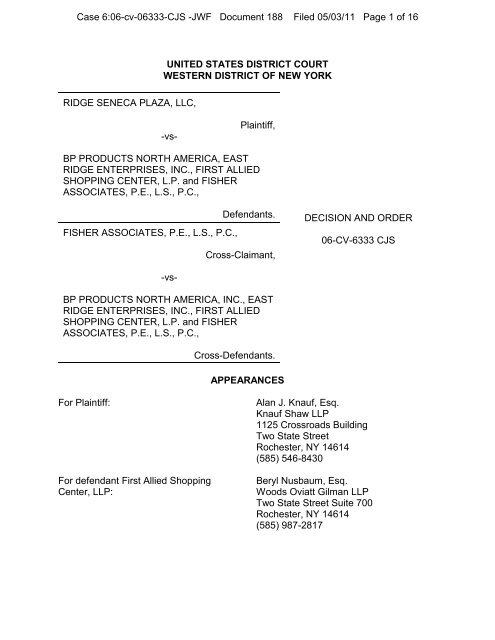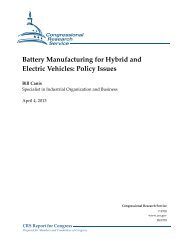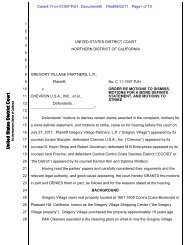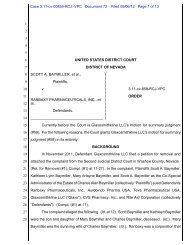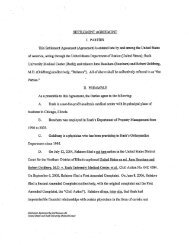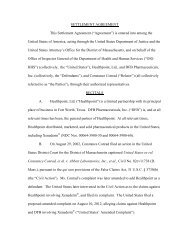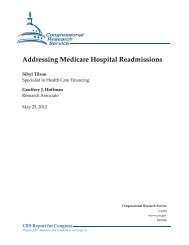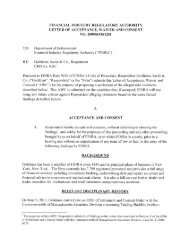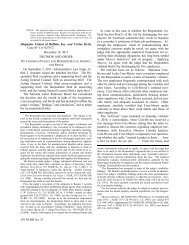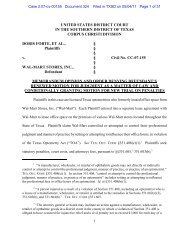Ridge Seneca Plaza, LLC v. BP Prods. N. Am. - BNA
Ridge Seneca Plaza, LLC v. BP Prods. N. Am. - BNA
Ridge Seneca Plaza, LLC v. BP Prods. N. Am. - BNA
You also want an ePaper? Increase the reach of your titles
YUMPU automatically turns print PDFs into web optimized ePapers that Google loves.
Case 6:06-cv-06333-CJS -JWF Document 188 Filed 05/03/11 Page 1 of 16<br />
UNITED STATES DISTRICT COURT<br />
WESTERN DISTRICT OF NEW YORK<br />
RIDGE SENECA PLAZA, <strong>LLC</strong>,<br />
Plaintiff,<br />
<strong>BP</strong> PRODUCTS NORTH AMERICA, EAST<br />
RIDGE ENTERPRISES, INC., FIRST ALLIED<br />
SHOPPING CENTER, L.P. and FISHER<br />
ASSOCIATES, P.E., L.S., P.C.,<br />
FISHER ASSOCIATES, P.E., L.S., P.C.,<br />
Defendants.<br />
Cross-Claimant,<br />
DECISION AND ORDER<br />
06-CV-6333 CJS<br />
-vs-<br />
-vs-<br />
<strong>BP</strong> PRODUCTS NORTH AMERICA, INC., EAST<br />
RIDGE ENTERPRISES, INC., FIRST ALLIED<br />
SHOPPING CENTER, L.P. and FISHER<br />
ASSOCIATES, P.E., L.S., P.C.,<br />
Cross-Defendants.<br />
APPEARANCES<br />
For Plaintiff:<br />
For defendant First Allied Shopping<br />
Center, LLP:<br />
Alan J. Knauf, Esq.<br />
Knauf Shaw LLP<br />
1125 Crossroads Building<br />
Two State Street<br />
Rochester, NY 14614<br />
(585) 546-8430<br />
Beryl Nusbaum, Esq.<br />
Woods Oviatt Gilman LLP<br />
Two State Street Suite 700<br />
Rochester, NY 14614<br />
(585) 987-2817
Case 6:06-cv-06333-CJS -JWF Document 188 Filed 05/03/11 Page 2 of 16<br />
INTRODUCTION<br />
Siragusa, J. This case, brought by <strong>Ridge</strong> <strong>Seneca</strong> <strong>Plaza</strong>, <strong>LLC</strong> (“<strong>Ridge</strong> <strong>Seneca</strong>”) is<br />
before the Court on a motion for summary judgment (Docket No. 104) filed by First Allied<br />
1<br />
Shopping Center, L.P. (“First Allied”). For the reasons stated below, the Court grants the<br />
application.<br />
FACTUAL BACKGROUND<br />
Pursuant to Western District of New York Local Rule, both parties submitted<br />
statements of fact. W.D.N.Y. Loc. R. Civ. P. 56 (2011). The source of the following<br />
background is from the parties’ statements and not in dispute, except where indicated<br />
below. <strong>Ridge</strong> <strong>Seneca</strong> <strong>Plaza</strong> (referred to as the “Premises” in the Purchase Agreement), the<br />
property that is the subject matter of this lawsuit, is located at the intersection of the<br />
northwest corner of <strong>Seneca</strong> Avenue and the south side of <strong>Ridge</strong> Road East in Rochester,<br />
New York, and is owned by Plaintiff <strong>Ridge</strong> <strong>Seneca</strong> <strong>Plaza</strong>, <strong>LLC</strong> (“<strong>Ridge</strong> <strong>Seneca</strong>”). <strong>Ridge</strong><br />
<strong>Seneca</strong> <strong>Plaza</strong>, <strong>LLC</strong> (“<strong>Ridge</strong> <strong>Seneca</strong>”) purchased this property from First Allied in February<br />
of 2001 under the terms of a contract dated September 14, 2000, as amended on January<br />
11, 200I. The purchase contract was originally entered into by First Allied with Sylvan<br />
Enterprise Corp. (“Sylvan”) and Sylvan assigned the contract to <strong>Ridge</strong> <strong>Seneca</strong> on the day<br />
of closing, February 27, 2001. Sylvan and <strong>Ridge</strong> <strong>Seneca</strong> were both represented by Harter<br />
Secrest & Emery LLP, and First Allied was represented by Woods Oviatt Gilman LLP.<br />
1<br />
The motion for summary judgment (Docket No. 102) filed by Fisher Associates, P.E., L.S.,<br />
P.C., was heard by U.S. Magistrate Judge Jonathan W. Feldman on consent of the parties. (See<br />
Docket No. 125, Consent and Reference of a Dispositive Motion to a Magistrate Judge.) Judge<br />
Feldman granted Fisher’s motion for summary judgment in a decision and order filed on March 28,<br />
2011 (Docket No. 180).<br />
Page 2 of 16
Case 6:06-cv-06333-CJS -JWF Document 188 Filed 05/03/11 Page 3 of 16<br />
Sylvan and <strong>Ridge</strong> <strong>Seneca</strong> were both managed and controlled by Rabbi Shlomo<br />
Noble (“Noble”), who executed the assignment of the Contract on the part of both Sylvan<br />
and <strong>Ridge</strong> <strong>Seneca</strong>. The Purchase Agreement provided in Paragraph 6, as follows:<br />
6. Condition of Premises.<br />
6.1 Buyer specifically acknowledges and agrees that Seller shall sell and<br />
Buyer shall purchase the Premises “as is, where is and with all faults” and<br />
Buyer is not relying on any representations or warranties of any kind<br />
whatsoever, whether oral or written, express or implied, statutory or<br />
otherwise, from Seller, nor any partner, officer, employee, attorney, agent or<br />
broker of Seller, as to any matter, concerning the Premises, or set forth,<br />
contained or addressed in any materials provided by Seller to Buyer with<br />
respect to the Premises (including without limitation, the completeness<br />
thereof). Without limiting the generality of the foregoing, Buyer expressly<br />
acknowledges and agrees that Buyer is not relying on any representation or<br />
warranty of Seller, nor any partner, officer, employee, attorney, agent or<br />
broker of Seller, whether implied, presumed or expressly provided at law or<br />
otherwise, arising by virtue of any statute, common law or other legally<br />
binding right or remedy in favor of Buyer. Buyer further acknowledges and<br />
agrees that Seller is under no duty to make any inquiry regarding any matter<br />
that may or may not be known to Seller or any partner, officer, employee,<br />
attorney, agent or broker of Seller. This Section shall survive the Closing, or,<br />
if the Closing does not occur, beyond the termination of this Agreement.<br />
6.3 Buyer, for itself and any successors and assigns of Buyer, waives its<br />
right to recover from, and forever releases and discharges, and covenants<br />
not to sue, Seller, Seller’s property and asset managers, any lender to Seller,<br />
the partners, trustees, shareholders, controlling persons, directors, officers,<br />
attorneys, employees and agents of each of them, and their respective heirs,<br />
successors, personal representatives and assigns (each a “Seller Party”, and<br />
collectively, the “Seller Parties”) with respect to any and all claims, whether<br />
direct or indirect, known or unknown, foreseen or unforeseen, that may arise<br />
on account of or in any way be connected with the Premises including,<br />
without limitation, the physical, environmental and structural condition of the<br />
Premises or any law or regulation applicable thereto (including, without<br />
limitation, any claim or matter relating to the use, presence, discharge or<br />
release of hazardous materials on, under, in. above or about the Premises);<br />
provided, however, Buyer does not waive its right under Section 12 hereof<br />
in connection with any default by Seller hereunder. This Section 6.3 shall<br />
survive the Closing. (Exhibit F)<br />
Page 3 of 16
Case 6:06-cv-06333-CJS -JWF Document 188 Filed 05/03/11 Page 4 of 16<br />
(Purchase Agreement 6–6.3.) The Purchase Agreement further provided pertinent part<br />
as follows:<br />
For the period from the Effective Date to twelve o’clock noon on October 30,<br />
2000 (the “Review Period”). Buyer shall have the right to inspect all aspects<br />
of the Premises including the leases and contracts in effect and all existing<br />
governmental approvals, and, in connection therewith, shall have the right at<br />
all reasonable times to enter onto the Premises in order to inspect the<br />
Premises and to conduct such tests as Buyer deems appropriate (subject to<br />
the terms of Section 3.2 below). If Buyer is dissatisfied with its investigations,<br />
Buyer shall have the right to terminate this Agreement at any time on or<br />
before twelve o’clock noon on the last day of’ the Review Period, by<br />
providing written notice of termination to Seller on or before the expiration of<br />
the Review Period.<br />
(Contract 3.1.)<br />
During the negotiation of the Purchase Agreement, and prior to the closing, there<br />
were never any discussions between representatives of Sylvan or <strong>Ridge</strong> <strong>Seneca</strong> and<br />
representatives of First Allied concerning the environmental condition of the property.<br />
<strong>Am</strong>endment No. 1 to the contract provided in pertinent part as follows:<br />
1. Buyer and Seller agree that the Contract is hereby reinstated and in full<br />
force and effect as amended by the terms of this <strong>Am</strong>endment.<br />
2. Section 3.1 shall be deleted in its entirety, it being understood that Buyer<br />
has reviewed its contingency described therein and accepts the Property in<br />
its “as is” “where is” condition. Buyer acknowledges that Buyer has<br />
completed its investigations pursuant to section 3.2.…<br />
6. Except as amended hereby, all terms and conditions of the Contract shall<br />
remain unmodified and in full force and effect.<br />
(First <strong>Am</strong>endment to Agreement to Purchase 1–2, 6.) The <strong>Am</strong>endment is consistent with<br />
Paragraph 6.1 of the Purchase Agreement, which provided that the property would be<br />
purchased “as is, where is and with all faults” and that there were no representations<br />
Page 4 of 16
Case 6:06-cv-06333-CJS -JWF Document 188 Filed 05/03/11 Page 5 of 16<br />
whatsoever of any condition of the property on the part of First Allied, as well as the<br />
release provisions of Paragraph 6.3.<br />
Pursuant to Paragraph 6.2 of the Purchase Agreement, Sylvan engaged Fisher<br />
Associates, P.E., L.S., P.C. to conduct a Phase I environmental study of the property. No<br />
Phase II environmental study was conducted prior to the closing.<br />
In 2005, <strong>Ridge</strong> <strong>Seneca</strong> sought a new mortgage from Washington Mutual Bank and<br />
at that time petroleum was discovered under the property. There is no source of petroleum<br />
on the property itself and, although Plaintiff’s original complaint included claims under the<br />
Oil Spill Law of the State of New York against First Allied, <strong>Ridge</strong> <strong>Seneca</strong> withdrew all<br />
claims made under that law against First Allied when it filed its amended complaint. In its<br />
amended complaint, <strong>Ridge</strong> <strong>Seneca</strong> included a claim against First Allied under the<br />
Comprehensive Environmental Response, Compensation, and Liability Act, Section 107,<br />
but Plaintiff has since withdrawn that claim as well.<br />
the following:<br />
<strong>Ridge</strong> <strong>Seneca</strong> has four remaining causes of action against First Allied, which are<br />
AS AND FOR A SECOND CAUSE OF ACTION FOR MISTAKE AGAINST<br />
FIRST ALLIED, PLAINTIFF ALLEGES AS FOLLOWS:<br />
97. Plaintiff repeats and realleges paragraphs “1" through “96" of this<br />
<strong>Am</strong>ended Complaint, as if set forth in this paragraph at length.<br />
98. Plaintiff, Sylvan and First Allied mistakenly believed that the Property was<br />
free of Contamination and did not require remediation, and based upon this<br />
mistaken fact, entered into or accepted the Purchase Agreement and/or held<br />
the Closing and recorded the Deed.<br />
99. Plaintiff’s mistaken belief regarding the Contamination and the lack of<br />
need for remediation was made despite its exercise of ordinary care in<br />
entering into the Purchase Agreement and investigating the Property.<br />
Page 5 of 16
Case 6:06-cv-06333-CJS -JWF Document 188 Filed 05/03/11 Page 6 of 16<br />
100. This mistake was material in that the lack of Contamination on the<br />
Property was a fundamental assumption of the Purchase Agreement, and a<br />
fact which vitally affected the basis on which the Purchase Agreement was<br />
made, and the Closing was held.<br />
101. First Allied was not a party to the Assignment, and plaintiff never agreed<br />
to the Purchase Agreement.<br />
102. Accordingly, plaintiff is not bound by any “as is,” waiver or release<br />
contained in the Purchase Agreement.<br />
103. Further, enforcement of the “as is” and waivers or release contained in<br />
the Purchase Agreement that First Allied may claim survived the Closing<br />
would not only result in the unjust enrichment of First Allied at the expense<br />
of plaintiff, but would be unconscionable.<br />
104. Accordingly, this Court should not enforce the Purchase Agreement<br />
against plaintiff, or should, in equity, reform the Purchase Agreement and the<br />
resulting Closing, so as to rescind any portions of the Purchase Agreement<br />
that survived the Closing, make an adjustment in the purchase price so that<br />
First Alliance is directed to reimburse plaintiff for the costs of investigation<br />
and remediation of the Contamination, and/or grant rescission or other<br />
appropriate equitable relief.<br />
* * *<br />
AS AND FOR AN TWELFTH CAUSE OF ACTION FOR NEGLIGENCE<br />
AGAINST GLAZER AND FIRST ALLIED, PLAINTIFF ALLEGES AS<br />
FOLLOWS:<br />
141. Plaintiff repeats and realleges the allegations of paragraphs “1" through<br />
“140" of this <strong>Am</strong>ended Complaint, as if set forth in this paragraph at length.<br />
142. Defendants (including their officers, agents, servants, and/or<br />
employees) owed a duty of care to plaintiff and others with regard to their<br />
use, ownership and operation of the Property and investigation and<br />
disclosure of activities on or information related to the Property, including<br />
disclosure of the EMG Phase I (in the case of First Allied), and/or otherwise<br />
in connection with the Property.<br />
143. Defendants (including their officers, agents, servants, and/or<br />
employees) acted unreasonably and negligently in: (a) failing to detect the<br />
Discharges, Releases, and/or Contamination; (b) First Allied failing to<br />
disclose to plaintiff the EMG Phase I; and (c) Glazer failing to take<br />
reasonable precautions necessary to prevent the Releases and/or the PCE<br />
Page 6 of 16
Case 6:06-cv-06333-CJS -JWF Document 188 Filed 05/03/11 Page 7 of 16<br />
Contamination; and those acts or omissions were a direct and proximate<br />
cause of the damages to plaintiff.<br />
144. Defendants, by reason of their negligence, are liable for all of the<br />
damages to plaintiff proximately caused by the Contamination, and<br />
investigation, cleanup and removal of the Contamination.<br />
* * *<br />
AS AND FOR A FOURTEENTH CAUSE OF ACTION FOR EQUITABLE OR<br />
IMPLIED INDEMNIFICATION AGAINST DEFENDANTS GLAZER AND<br />
FIRST ALLIED, PLAINTIFF ALLEGES AS FOLLOWS:<br />
149. Plaintiff repeats and realleges the allegations of paragraphs “1" through<br />
“148" of this <strong>Am</strong>ended Complaint, as if set forth in this paragraph at length.<br />
150. Defendant Glazer, including his agents, servants, and/or employees,<br />
had a non-delegable duty to plaintiff to clean up or ensure against the PCE<br />
Contamination of the Property.<br />
151. As a result of the breach of this duty by defendant Glazer, including his<br />
agents, servants, and/or employees, he is responsible for plaintiff’s past and<br />
future expenses and damages in investigation, remediation, cleanup, and<br />
removal of, and response to, the PCE Contamination, and as a result,<br />
defendant Glazer should, in equity, indemnify plaintiff for some or all of its<br />
expenses, costs, and damages.<br />
AS AND FOR A FIFTEENTH CAUSE OF ACTION FOR RESTITUTION<br />
AGAINST DEFENDANTS GLAZER AND FIRST ALLIED, PLAINTIFF<br />
ALLEGES AS FOLLOWS:<br />
152. Plaintiff repeats and realleges the allegations of paragraphs “1" through<br />
“151" of this <strong>Am</strong>ended Complaint, as if set forth in this paragraph at length.<br />
153. It would be against equity and good conscience to permit defendants<br />
Glazer and First Allied to pass the burden of cleaning up the Contamination<br />
to plaintiff, and for defendant First Allied to have had the benefit of<br />
enjoyment of the use of the Property, free of any responsibility for<br />
investigation, remediation, cleanup, and removal of, and response to, the<br />
Contamination.<br />
154. Therefore, defendants Glazer and First Allied should make restitution<br />
to plaintiff for some or all of its expenses, costs, and damages.<br />
(<strong>Am</strong>end. Compl. 97–104, 141–54.)<br />
Page 7 of 16
Case 6:06-cv-06333-CJS -JWF Document 188 Filed 05/03/11 Page 8 of 16<br />
The source of the petroleum contamination on the property is evidently from the<br />
former East <strong>Ridge</strong> Enterprise, Inc., gasoline station on the northeast corner of <strong>Seneca</strong><br />
Avenue and <strong>Ridge</strong> Road East. First Allied contends, and <strong>Ridge</strong> <strong>Seneca</strong> disputes, that there<br />
is no documentation identifying when petroleum contamination first entered the property,<br />
and that there is no documentation as to whether petroleum contamination affected the<br />
property prior to February 27, 2001.<br />
STANDARD OF LAW<br />
The standard for granting summary judgment is well established. Summary<br />
judgment may not be granted unless “the pleadings, depositions, answers to interrogatories,<br />
and admissions on file, together with the affidavits, if any, show that there is no<br />
genuine issue as to any material fact and that the moving party is entitled to a judgment<br />
as a matter of law.” Fed. R. Civ. P. 56(c). A party seeking summary judgment bears the<br />
burden of establishing that no genuine issue of material fact exists. See Adickes v. S.H.<br />
Kress & Co., 398 U.S. 144, 157 (1970).<br />
“[T]he movant must make a prima facie showing<br />
that the standard for obtaining summary judgment has been satisfied.” 11 MOORE’S<br />
FEDERAL PRACTICE, § 56.11[1][a] (Matthew Bender 3d ed.). That is, the burden is on the<br />
moving party to demonstrate that the evidence creates no genuine issue of material fact.<br />
See <strong>Am</strong>aker v. Foley, 274 F.3d 677 (2d Cir. 2001); Chipollini v. Spencer Gifts, Inc., 814<br />
F.2d 893 (3d Cir.1987) (en banc). Where the non-moving party will bear the burden of<br />
proof at trial, the party moving for summary judgment may meet its burden by showing the<br />
evidentiary materials of record, if reduced to admissible evidence, would be insufficient to<br />
carry the non-movant’s burden of proof at trial. Celotex Corp. v. Catrett, 477 U.S. 317,<br />
322–23 (1986).<br />
Page 8 of 16
Case 6:06-cv-06333-CJS -JWF Document 188 Filed 05/03/11 Page 9 of 16<br />
Once that burden has been met, the burden then shifts to the non–moving party to<br />
demonstrate that, as to a material fact, a genuine issue exists. Fed. R. Civ. P. 56(e);<br />
Anderson v. Liberty Lobby, Inc., 477 U.S. 242, 250 (1986). A fact is “material” only if the<br />
fact has some affect on the outcome of the suit. Catanzaro v. Weiden, 140 F.3d 91, 93 (2d<br />
Cir. 1998). A dispute regarding a material fact is genuine “if the evidence is such that a<br />
reasonable jury could return a verdict for the nonmoving party.” Anderson, 477 U.S. at 248.<br />
In determining whether a genuine issue exists as to a material fact, the court must view<br />
underlying facts contained in affidavits, attached exhibits, and depositions in the light most<br />
favorable to the non-moving party. U.S. v. Diebold, Inc., 369 U.S. 654, 655 (1962).<br />
Moreover, the court must draw all reasonable inferences and resolve all ambiguities in<br />
favor of the non-moving party. Leon v. Murphy, 988 F.2d 303, 308 (2d Cir.1993);<br />
Anderson, 477 U.S. at 248-49; Doe v. Dep’t of Pub. Safety ex rel. Lee, 271 F.3d 38, 47 (2d<br />
Cir. 2001), rev’d on other grounds Connecticut Dept. of Public Safety v. Doe, 538 U.S. 1,<br />
123 S.Ct. 1160 (2003); International Raw Materials, Ltd. v. Stauffer Chemical Co., 898 F.2d<br />
946 (3d Cir. 1990). However, a summary judgment motion will not be defeated on the basis<br />
of conjecture or surmise or merely upon a “metaphysical doubt” concerning the facts.<br />
Bryant v. Maffucci, 923 F.2d 979, 982 (2d Cir. 1991) (citing Matsushita Elec. Indus. Co.,<br />
Ltd. v. Zenith Radio Corp., 475 U.S. 574, 586 (1986)); Knight v. United States Fire Ins. Co.,<br />
804 F.2d 9 (2d Cir. 1986). Rather, evidentiary proof in admissible form is required. Fed. R.<br />
Civ. P. 56(e). Furthermore, the party opposing summary judgment “may not create an<br />
issue of fact by submitting an affidavit in opposition to a summary judgment motion that,<br />
by omission or addition, contradicts the affiant’s previous deposition testimony.” Hayes v.<br />
Page 9 of 16
Case 6:06-cv-06333-CJS -JWF Document 188 Filed 05/03/11 Page 10 of 16<br />
New York City, Department of Corrections, 84 F.3d 614, 619 (2d Cir. 1996).<br />
ANALYSIS<br />
First Allied’s Alleged Negligence in Failing to Disclose the EMG Phase I Report to<br />
<strong>Ridge</strong> <strong>Seneca</strong><br />
<strong>Ridge</strong> <strong>Seneca</strong> argues that First Allied had a duty to disclose “all material information<br />
regarding the environmental condition of the Property prior to Closing….” (<strong>Ridge</strong> <strong>Seneca</strong><br />
Mem. of Law at 2–3.) In particular, <strong>Ridge</strong> <strong>Seneca</strong> refers to the EMG Phase I completed on<br />
March 14, 1997, (<strong>Am</strong>end. Compl. 143(b)), which discussed a 1994 tank failure at the<br />
gasoline station adjacent to the Property, and pointed out that a dry cleaner had operated 2<br />
prior to regulations on the disposal of hazardous dry cleaning waste. <strong>Ridge</strong> <strong>Seneca</strong> relies<br />
on Stambovsky v. Ackley, 169 A.D.2d 254 (N.Y. App. Div. 1st Dept. 1991) and Young v.<br />
Keith, 112 A.D.2d 625 (N.Y. App. Div. 3d Dept. 1985), to support its contention that First<br />
Allied had a duty to disclose even in the absence of a specific inquiry from <strong>Ridge</strong> <strong>Seneca</strong>.<br />
(<strong>Ridge</strong> <strong>Seneca</strong> Mem. of Law at 4.) First Allied counters:<br />
New York adheres to the doctrine of caveat emptor and imposes no duty on<br />
the seller to disclose any information concerning the premises when the<br />
parties deal at arm’s length, unless there is some conduct on the part of the<br />
seller that constitutes active concealment (see, Platzman v Morris, 283<br />
A.D.2d 561, 562 (2d Dep’t 2001); Howard Iron Works v. Buffalo Elevating<br />
3<br />
Co., 113 A.D. 562, 570 (4th Dep’t 1901) ).<br />
(First Allied Mem. of Law at 5.) Howard Iron Works dealt with the sale of personal property,<br />
so is not relevant here, but in Platzman, cited in Howard, the appellate court, in a case<br />
2<br />
The papers submitted in support of, and in opposition to, the motion, do not indicate<br />
whether the dry cleaner operated on the premises sold, or on an adjacent premises.<br />
3<br />
The Howard case was actually decided on May 9, 1906, not 1901, and was affirmed on<br />
May 10, 1907. Howard Iron Works v. Buffalo Elevating Co., 188 N.Y. 619 (1907).<br />
Page 10 of 16
Case 6:06-cv-06333-CJS -JWF Document 188 Filed 05/03/11 Page 11 of 16<br />
concerning the sale of a house with a condition that violated the local zoning ordinance,<br />
held that the purchaser was not entitled to relief. There, the Second Department wrote:<br />
New York adheres to the doctrine of caveat emptor and imposes no duty on<br />
the seller to disclose any information concerning the premises when the<br />
parties deal at arm’s length, unless there is some conduct on the part of the<br />
seller which constitutes active concealment (see, London v Courduff, 141<br />
AD2d 803; Stambovsky v Ackley, 169 AD2d 254). To maintain a cause of<br />
action to recover damages for active concealment in the context of a<br />
fraudulent nondisclosure, the plaintiffs must show, in effect, that the seller<br />
thwarted the plaintiffs’ effort to fulfill their responsibilities fixed by the doctrine<br />
of caveat emptor (see, London v Courduff, supra).<br />
Platzman v. Morris, 283 A.D.2d 561, 562 (N.Y. App. Div. 2d Dep’t 2001).<br />
The Court agrees with First Allied’s position and finds that the cases relied upon by<br />
<strong>Ridge</strong> <strong>Seneca</strong> are distinguishable. In Stambovsky v. Ackley, 169 A.D.2d 254 (N.Y. App.<br />
Div. 1st Dep’t 1991), cited by <strong>Ridge</strong> <strong>Seneca</strong>, the First Department allowed the New York<br />
City purchaser of a house in the Village of Nyack to rescind the purchase on the basis that<br />
the seller failed to disclose that the house was reputed to be haunted:<br />
The case law in this jurisdiction dealing with the duty of a vendor of real<br />
property to disclose information to the buyer is distinguishable from the<br />
matter under review. The most salient distinction is that existing cases<br />
invariably deal with the physical condition of the premises (e.g., London v<br />
Courduff, supra [use as a landfill]; Perin v Mardine Realty Co., 5 AD2d 685,<br />
affd 6 NY2d 920 [sewer line crossing adjoining property without owner’s<br />
consent]), defects in title (e.g., Sands v Kissane, 282 App Div 140<br />
[remainderman]), liens against the property (e.g., Noved Realty Corp. v A.<br />
A. P. Co., supra), expenses or income (e.g., Rodas v Manitaras, supra [gross<br />
receipts]) and other factors affecting its operation. No case has been brought<br />
to this court’s attention in which the property value was impaired as the result<br />
of the reputation created by information disseminated to the public by the<br />
seller (or, for that matter, as a result of possession by poltergeists).<br />
Where a condition which has been created by the seller materially impairs<br />
the value of the contract and is peculiarly within the knowledge of the seller<br />
or unlikely to be discovered by a prudent purchaser exercising due care with<br />
respect to the subject transaction, nondisclosure constitutes a basis for<br />
rescission as a matter of equity. Any other outcome places upon the buyer<br />
Page 11 of 16
Case 6:06-cv-06333-CJS -JWF Document 188 Filed 05/03/11 Page 12 of 16<br />
not merely the obligation to exercise care in his purchase but rather to be<br />
omniscient with respect to any fact which may affect the bargain. No practical<br />
purpose is served by imposing such a burden upon a purchaser. To the<br />
contrary, it encourages predatory business practice and offends the principle<br />
that equity will suffer no wrong to be without a remedy.<br />
Stambovsky, 169 A.D. 2d at 260. <strong>Ridge</strong> <strong>Seneca</strong> also cites to Young v. Keith, 112 A.D.2d<br />
625 (N.Y. App. Div. 3d Dept. 1985). In Young, the court wrote:<br />
nondisclosure may constitute a false representation where a party has a duty<br />
to communicate the undisclosed information to the other contracting party<br />
(24 NY Jur, Fraud and Deceit, § 106, at 159). Such a duty can arise when<br />
one party to a contract has superior knowledge which is not available to both<br />
parties (24 NY Jur, Fraud and Deceit, § 108, at 162). As the Court of Appeals<br />
has stated, “Concealment with intent to defraud of facts which one is<br />
duty-bound in honesty to disclose is of the same legal effect and significance<br />
as affirmative misrepresentations of fact” (Nasaba Corp. v Harfred Realty<br />
Corp., 287 NY 290, 295). Considering the allegations that the mobile home<br />
park was sold as an operating business and that the sewer and water<br />
systems’ deficiencies were known by defendants to require very expensive<br />
reconstruction and to pose a threat to the business’ operating license, a duty<br />
to disclose the deficiencies could be found. Plaintiff’s complaint can be<br />
further read to allege that they could not have discovered the deficiencies<br />
through an ordinary inspection and that they would not have purchased the<br />
property had they known of them.<br />
Young, 112 A.D.2d at 626–27.<br />
From these and other cases cited by <strong>Ridge</strong> <strong>Seneca</strong> in its memorandum of law, the<br />
Court concludes that in order to maintain a cause of action for failing to disclose the<br />
existence of the EMG Phase I report, <strong>Ridge</strong> <strong>Seneca</strong> would have to show that First Allied<br />
actively concealed the report or the conditions on which it reported, or, as in the case of<br />
a haunted house,<br />
a very practical problem arises with respect to the discovery of a paranormal<br />
phenomenon: “Who you gonna’ call” as a title song to the movie<br />
“Ghostbusters” asks. Applying the strict rule of caveat emptor to a contract<br />
involving a house possessed by poltergeists conjures up visions of a psychic<br />
or medium routinely accompanying the structural engineer and Terminix man<br />
on an inspection of every home subject to a contract of sale. It portends that<br />
Page 12 of 16
Case 6:06-cv-06333-CJS -JWF Document 188 Filed 05/03/11 Page 13 of 16<br />
the prudent attorney will establish an escrow account lest the subject of the<br />
transaction come back to haunt him and his client—or pray that his<br />
malpractice insurance coverage extends to supernatural disasters. In the<br />
interest of avoiding such untenable consequences, the notion that a haunting<br />
is a condition which can and should be ascertained upon reasonable<br />
inspection of the premises is a hobgoblin which should be exorcised from the<br />
body of legal precedent and laid quietly to rest.<br />
Stambovsky, 169 A.D.2d at 257. No evidentiary proof in the record shows active<br />
concealment, or a situation that could not be ascertained upon reasonable inspection of<br />
the premises, especially considering the commercial entities that were parties to the<br />
transaction.<br />
Purchase Agreement between First Allied and Sylvan Enterprise Corp.<br />
First Allied contends that <strong>Ridge</strong> <strong>Seneca</strong> is bound by the terms of the purchase<br />
agreement between First Allied and Sylvan, which assigned the contract to <strong>Ridge</strong> <strong>Seneca</strong>.<br />
<strong>Ridge</strong> <strong>Seneca</strong> counters that,“while the rights in the Purchase Agreement were assigned<br />
to [it], the associated burdens were not.” (<strong>Ridge</strong> <strong>Seneca</strong> Mem. of Law at 7.) In other words,<br />
it apparently is <strong>Ridge</strong> <strong>Seneca</strong>’s position that they are therefore not bound by the terms of<br />
the contract between Sylvan and First Allied, whereby Sylvan purchased the property “as<br />
is, where is and with all faults.”<br />
In Langel v. Betz, 250 N.Y. 159, 161 (1928), the New York Court of Appeals<br />
reviewed the question of whether an assignee of a contract is bound by the contract’s<br />
obligations, as well as being entitled to the benefits of the contract. See also Kaufman v.<br />
William Iselin & Co., 272 A.D. 578, 581 (N.Y. App. Div. 1st Dep’t 1947) (“The question<br />
whether an assignee assumes the duties as well as the rights under an assigned contract<br />
was considered at length by the Court of Appeals in Langel v. Betz, 250 N.Y. 159, 163, 164<br />
N.E. 890, 891.”). In Langel, the Court wrote:<br />
Page 13 of 16
Case 6:06-cv-06333-CJS -JWF Document 188 Filed 05/03/11 Page 14 of 16<br />
The mere assignment of a bilateral executory contract may not be interpreted<br />
as a promise by the assignee to the assignor to assume the performance of<br />
the assignor’s duties, so as to have the effect of creating a new liability on<br />
the part of the assignee to the other party to the contract assigned. The<br />
assignee of the vendee is under no personal engagement to the vendor<br />
where there is no privity between them.<br />
Langel, 250 N.Y. 161–62. However, the Court of Appeals in Langel then pointed out that<br />
a contrary interpretation may result where circumstances surrounding the assignment itself<br />
indicate a promise on the part of the assignee to assume the assignor’s duties. Id. at 163.<br />
Here, the Assignment of Purchase Agreement signed by Nobel as assignor and as<br />
one of the assignees, reads in pertinent part as follows:<br />
KNOW ALL BY THESE PRESENTS, that Sylvan Enterprises Corp.…<br />
(“Assignor”), for good and valuable consideration…, hereby assigns and<br />
conveys to <strong>Ridge</strong> <strong>Seneca</strong> <strong>Plaza</strong>, <strong>LLC</strong>, …all right, title, and interest of<br />
Assignor in and to that certain Purchase Agreement by and between<br />
Assignor and First Allied Shopping Center, L.P. (“Seller”), dated September<br />
14, 2000, as amended by that certain First <strong>Am</strong>endment to Agreement to<br />
Purchase between Assignor and Seller dated January 11, 2001 (collectively,<br />
the “Contract”), relating to certain property located in the City of Rochester,<br />
County of Monroe, and State of New York, known as <strong>Ridge</strong> <strong>Seneca</strong> <strong>Plaza</strong><br />
and more particularly described in the Contract (the “Premises”).<br />
TO HAVE AND TO HOLD the said Contract unto Assignee, its successors<br />
and assigns, to its and their use and behoof [sic] forever.<br />
(Nussbaum Aff. Ex. J.) What Sylvan assigned to <strong>Ridge</strong> <strong>Seneca</strong> was the entire Purchase<br />
Agreement including Paragraphs 6.1, 6.2 and 6.3, quoted above. Paragraph 6.1 specifies<br />
that the Property is being purchased “as is, where is and with all faults.” Paragraph 6.2<br />
makes clear that, “[a]ny reports, repairs or work required by Buyer are the sole<br />
responsibility of Buyer, and Buyer agrees that there is no obligation on the part of Seller<br />
to make any changes, alterations or repairs to the Premises or to cure any violations of law<br />
or to comply with the requirements of any insurer.” (Purchase Agreement 6.2.) Finally,<br />
Page 14 of 16
Case 6:06-cv-06333-CJS -JWF Document 188 Filed 05/03/11 Page 15 of 16<br />
Paragraph 6.3, binds not only the buyer to the terms of the contract, but also any<br />
successors and assignees of Buyer. <strong>Ridge</strong> <strong>Seneca</strong>’s citations to eight cases in its<br />
memorandum of law do not support a contrary conclusion.<br />
<strong>Ridge</strong> <strong>Seneca</strong>’s Mutual Mistake Claim<br />
<strong>Ridge</strong> <strong>Seneca</strong> claims that its purchase of the Premises was based on a mutual<br />
mistake of fact. First, it contends that while First Allied should have disclosed the EMG<br />
Phase I report. In the alternative, <strong>Ridge</strong> <strong>Seneca</strong> argues that if First Allied did not understand<br />
the significance of the report’s findings, then it did not perceive the true condition of<br />
the property and was, therefore, mistaken as to the condition of the property it was selling.<br />
(<strong>Ridge</strong> <strong>Seneca</strong> Mem. of Law at 9.)<br />
The general rule in New York is that “a contract is voidable under the equitable<br />
remedy of rescission if the parties entered into the contract under a mutual mistake of fact<br />
which is substantial and existed at the time the contract was entered into.” Rekis v. Lake<br />
Minnewaska Mountain Houses, Inc., 170 A.D.2d 124, 130 (N.Y. App. Div. 3d Dep’t 1991)<br />
(citations omitted). “An objective test is used to determine whether there has been a mutual<br />
mistake….” Ryan v. Boucher, 144 A.D.2d 144, 145 (N.Y. App. Div. 3d Dep’t 1988) (citation<br />
omitted).<br />
The assigned contract contained no representations as to the condition of the<br />
premises that First Allied was selling to Sylvan in the contract assigned to <strong>Ridge</strong> <strong>Seneca</strong>.<br />
Instead, the contract specifically left it to the purchaser to determine whether the condition<br />
of the property was such that the purchaser did not want to purchase it. The Court has<br />
twice, above, quoted paragraphs 6.1 and 6.3 of the Purchase Agreement. Those provisions<br />
made it clear that whether First Allied understood the significance of the EMG Phase I<br />
Page 15 of 16
Case 6:06-cv-06333-CJS -JWF Document 188 Filed 05/03/11 Page 16 of 16<br />
Report was irrelevant to the sale. First Allied was selling the property “as is, where is and<br />
with all faults” and <strong>Ridge</strong> <strong>Seneca</strong> has not shown that First Allied made any representations<br />
as to the property’s condition.<br />
CONCLUSION<br />
First Allied Shopping Center, LP’s motion (Docket No. 104) for summary judgment<br />
is granted. The following causes of action plead against it are dismissed:<br />
AS AND FOR A SECOND CAUSE OF ACTION FOR MISTAKE AGAINST<br />
FIRST ALLIED….<br />
AS AND FOR AN TWELFTH CAUSE OF ACTION FOR NEGLIGENCE<br />
AGAINST GLAZER AND FIRST ALLIED….<br />
AS AND FOR A FOURTEENTH CAUSE OF ACTION FOR EQUITABLE OR<br />
IMPLIED INDEMNIFICATION AGAINST DEFENDANTS GLAZER AND<br />
FIRST ALLIED….<br />
AS AND FOR A FIFTEENTH CAUSE OF ACTION FOR RESTITUTION<br />
AGAINST DEFENDANTS GLAZER AND FIRST ALLIED….<br />
It Is So Ordered.<br />
Dated: May 2, 2011<br />
Rochester, New York<br />
ENTER.<br />
/s/ Charles J. Siragusa<br />
CHARLES J. SIRAGUSA<br />
United States District Judge<br />
Page 16 of 16


